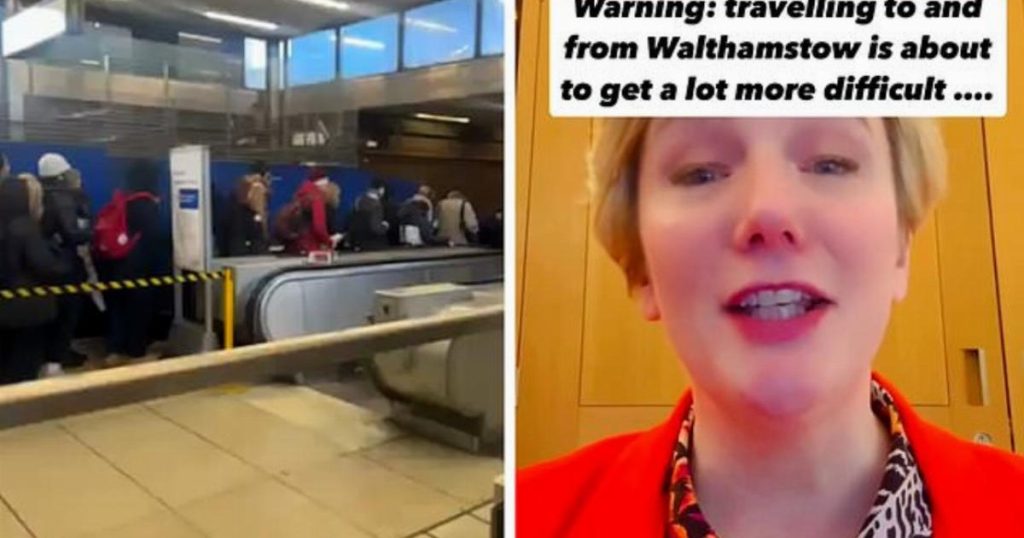The Blackhorse Road Underground station in Walthamstow, London, is facing a prolonged escalator closure for urgent repairs, causing significant disruption for commuters, particularly those with disabilities and mobility limitations. The closure, which is expected to last until late June, necessitates passengers walking down the stationary escalators, creating long queues and potential safety hazards. The situation is exacerbated by the reported unavailability of the lift at the nearby Walthamstow Central station, leaving wheelchair users without direct access to platforms at either station. This lack of accessibility has raised concerns about the adequacy of transportation options for disabled individuals in the area. Stella Creasy, the Member of Parliament for Walthamstow, has voiced her concerns regarding the disruption and the lack of accessibility, highlighting the challenges faced by wheelchair users and those with prams or heavy luggage.
The extended closure has prompted Ms. Creasy to request increased bus services between Blackhorse Road station and both Walthamstow Central and Tottenham Hale stations to mitigate the impact on commuters. Additionally, she has advocated for allowing more than the standard two buggies on buses operating between these stations to accommodate families with young children. Footage shared online depicting substantial queues of passengers waiting to descend the stationary escalators underscores the extent of the disruption. Ms. Creasy has advised passengers to consider alternative routes if possible to avoid the congestion and inconvenience at Blackhorse Road station. The escalator closure has sparked criticism of Transport for London (TfL) for the length of the disruption and the lack of readily available alternative accessible options for passengers.
TfL has issued an apology for the inconvenience caused by the escalator closure, emphasizing the necessity of the maintenance work to improve efficiency and safety. While acknowledging the disruption, TfL has encouraged passengers to travel during off-peak hours or utilize their travel planning tools to identify alternative routes. This incident highlights the challenges faced by commuters when essential infrastructure undergoes maintenance and the importance of accessible transportation options for all members of the community. The ongoing situation underscores the need for proactive communication and mitigation strategies from transport authorities to minimize the impact of such disruptions on passengers.
The escalator closure at Blackhorse Road station is not an isolated incident in London’s transport network. Last month, passengers at the Cutty Sark DLR station in Greenwich faced a similar ordeal when an escalator breakdown forced them to climb 121 steps. These incidents raise broader questions about the reliability and accessibility of London’s public transport infrastructure, particularly for individuals with mobility limitations. The prolonged nature of the Blackhorse Road escalator closure and the limited alternative options available highlight the need for improved contingency planning and communication from transport authorities in the event of such disruptions.
The incident at Blackhorse Road station also underscores the importance of investing in accessible infrastructure and ensuring the availability of reliable alternative transport options for disabled passengers. The reliance on lifts and escalators as primary means of access to platforms can create significant challenges when these systems are out of service. The situation calls for a more comprehensive approach to accessibility planning, including the provision of ramps, lifts, and other accessible routes, to ensure that all passengers can utilize public transport without facing undue hardship.
The ongoing disruption at Blackhorse Road station serves as a reminder of the vital role that accessible and reliable public transport plays in the lives of Londoners. The extended escalator closure and the limited alternative options highlight the need for continued investment in infrastructure improvements, contingency planning, and proactive communication from transport authorities to ensure a smooth and accessible commuting experience for all passengers. The incident also underscores the importance of advocating for the needs of disabled passengers and ensuring that their voices are heard in the planning and implementation of transport policies and infrastructure projects.




